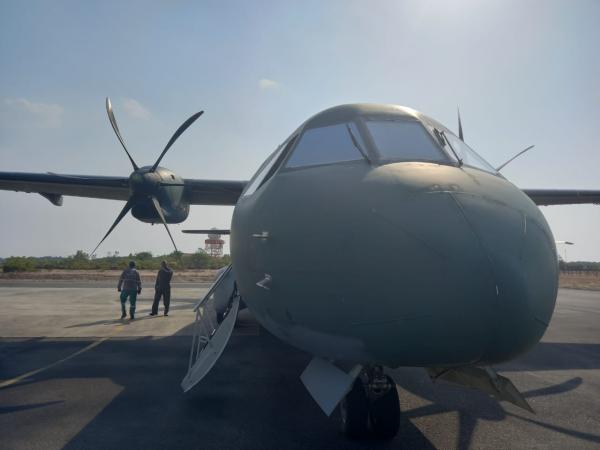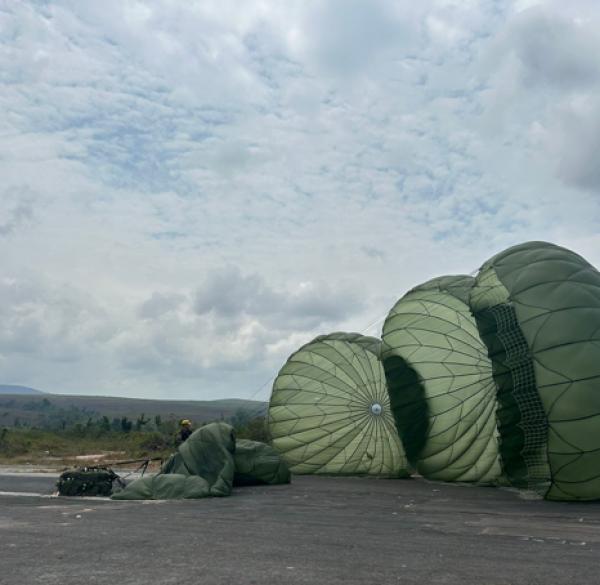In all, around 374 military personnel from the Armed Forces and 36 rotary-wing and fixed-wing aircraft were involved in the operation
Air Force Agency: Catrimani Joint Operational Command
A hot day, with few clouds and temperatures reaching 32ºC. This was the scenario that surrounded the last launches of food baskets to the communities of the Yanomami Indigenous Land (TIY), by Operation Catrimani, in Roraima. This milestone saw the participation of the First Fleet of the Ninth Aviation Group (1º/9º GAV) – Arara Squadron – which was responsible for launching 12 CDS (Container Delivery System), using two C-105 Amazonas aircraft from the Brazilian Air Force (FAB).
With intense aerial activities, in compliance with Ordinance GM-MD No. 263, of January 16, 2024, Operation Catrimani aims to provide humanitarian assistance to the indigenous communities of the TIY, on a temporary basis, through logistical support in the distribution of food baskets to the indigenous communities, as well as Aeromedical Evacuations (EVAM) and support for the Security Agencies.
The commander of one of the C-105 Amazonas aircraft, Captain Glauber Ribeiro Constantino, highlighted important aspects of the Fleet’s role in the operation. “The aerial resupply activity in support of the Yanomami people enabled the Fleet to masterfully fulfill its mission of integrating the Amazon region, developing the operational skills of its crews in aerial launches using the CDS method. In this context, the maximum capacity of the C-105 Amazonas aircraft to launch seven CDS in a single pass was also used, an unprecedented activity achieved by the Fleet. Everyone involved in the launch felt a sense of accomplishment and achievement,” he said.
In addition, the commander of the second C-105 Amazonas aircraft, Captain Talyson Monte de Almeida, stressed the gratitude of the entire crew at this milestone moment in the operation. “The feeling is one of mission accomplished, after a lot of effort and so many hours flown. For us, it’s a milestone to close this Operation and make this final launch of the baskets in support, once again, of the indigenous peoples of the TIY,” he said.
In all, Operation Catrimani involved 374 military personnel from the Brazilian Navy (MB), the Brazilian Army (EB) and FAB units throughout the country, as well as the use of rotary-wing and fixed-wing aircraft, such as the C-98 Caravan and the H-60L Black Hawk from the FAB; the HM-1 Pantera, the HM-2 Black Hawk and the HM-4 Jaguar from the EB; and the UH-15 Super Cougar from the MB. Acting in coordination and mutual support, the vectors engaged in the Operation have already logged 2,400 flight hours, delivering 360 tons of supplies to the indigenous communities of the TIY.
“Due to the conditions of the runway and the capacity of the Brazilian Air Force to carry out this type of launch, the use of the C-105 Amazonas aircraft has made it more efficient to transport the food baskets to Surucucu, at a lower cost than if they had been transported by C-98 Caravan aircraft, for example. In addition to this gain in efficiency, we were able to make our crews more trained for the real use of this capability that the FAB has,” explained the Chief of Staff of the Joint Operational Command (COpCj) Catrimani, Air Brigadier Eduardo Miguel Soares.

CDS launches
During the operation, supplies were dropped from C-105 Amazonas aircraft at a height of approximately 200 meters and arrived at the Fourth Special Border Platoon (4º PEF) in Surucucu with the help of parachutes, duly installed in the CDS. Together, the FAB and EB, through the Airborne Parachute Folding, Maintenance and Supply Battalion (B DOMPSA), carried out all the parachute installation work.
“The role of the DOMPSA specialist on medium cargo air launch missions is to support the crew with any information involving parachutes on the cargo. We are responsible for monitoring the loading of the cargo onto the aircraft, we are in a position to configure the cargo for launch, we support the crew with the launch itself and we also carry out functions in emergencies,” described the member of the Folding, Parachute Maintenance and Airborne Supplies Battalion (B DOMPSA), Sergeant Matheus de Souza Maia.


Reverse logistics
After the launches, teams on the ground in Surucucu, coordinated by B DOMPSA, collected all the parachute material and laces and awaited the arrival of the FAB C-98 Caravan aircraft, responsible for taking all the material back to Boa Vista Air Base (BABV), so that the parachutes could be folded and new CDS assembled for use in the next day’s launches.
Photos: Lieutenant Myrea Calazans / CECOMSAER *** Translated by DEFCONPress FYI Team ***
